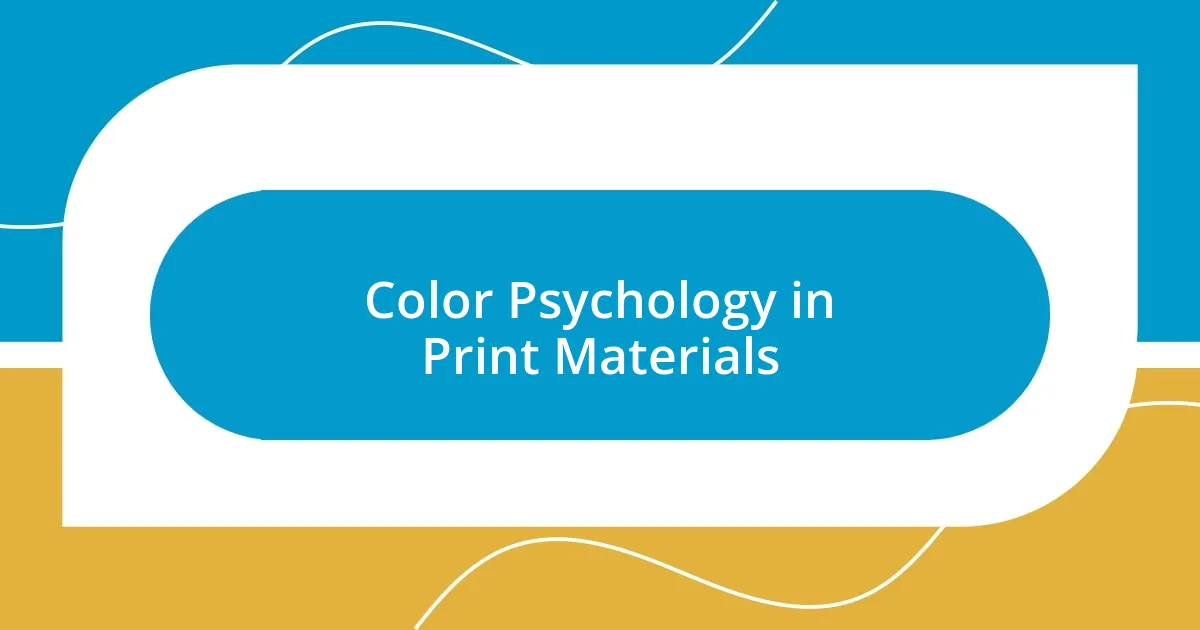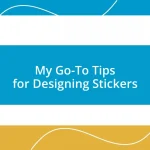Key takeaways:
- Minimalist design reflects societal trends towards simplicity and tranquility amidst clutter.
- Emerging print techniques like letterpress and risograph printing enhance tactile experiences and emotional connections with viewers.
- Sustainability in print design focuses on using eco-friendly materials and practices, aligning with consumer values.
- Integrating technology, such as AR and variable data printing, personalizes print projects and enhances engagement with audiences.

Understanding Print Design Trends
When I look at print design trends, I often find myself reflecting on how they mirror the societal changes around us. For instance, the increasing popularity of minimalist design not only emphasizes simplicity and functionality but also resonates with our fast-paced lives. Have you ever felt overwhelmed by clutter? I definitely have, and that’s why minimalist aesthetics are so compelling—they create a sense of tranquility.
I remember a project where I explored vibrant color gradients in print materials. At first, I was hesitant; after all, bold colors can sometimes overwhelm a design. But when I presented a piece using these gradients, it truly captivated the audience. It felt exhilarating to see how a simple shift in color could evoke excitement and energy, making the design come alive.
Trends like tactile printing and the use of unconventional materials are fascinating too. I’ve worked with textured finishes before, and the feedback was always heartening—people genuinely connect more when they can touch and feel the design. Isn’t it intriguing how something as simple as texture can enhance our experience with print? Exploring these trends not only enriches our designs but also deepens our understanding of how people interact with printed materials.

Current Popular Print Techniques
When it comes to current popular print techniques, one style that stands out is the resurgence of letterpress printing. This technique offers a tactile feel that many digital methods simply can’t replicate. I once experimented with letterpress for a friend’s wedding invitations; the result was stunning. The subtle indents and raised surfaces made each invitation feel like a unique piece of art. Have you ever received something you just wanted to keep for its texture? I can assure you, that’s what letterpress does—it turns the ordinary into something extraordinary.
Another technique that has gained traction is risograph printing. It’s like letterpress’s vibrant cousin, combining the precision of digital with the spontaneous feel of traditional methods. I had the chance to use risograph for a small batch of art prints, and I was amazed by the vibrant colors and the slight imperfections that came with each print. Those quirks enhanced the charm and authenticity of the pieces. I think it’s fascinating how these colorful mismatches can tell a story of their own, creating an emotional connection with the viewer.
Lastly, digital printing continues to dominate but is evolving. Today’s advancements allow for personalization at an incredible scale. I once worked on a project where we personalized postcards for a campaign, and the target audience felt compelled to engage because the design felt unique just for them. It’s incredible how print, often seen as static, can shift to be dynamic and personalized. Through these current techniques, we can keep print alive and thriving in a digital world.
| Print Technique | Key Features |
|---|---|
| Letterpress | Tactile finishes, indented designs, vintage feel |
| Risograph | Vibrant colors, slight imperfections, eco-friendly ink |
| Digital Printing | High customization, quick turnaround, evolving technology |

Sustainable Practices in Print Design
Adopting sustainable practices in print design is more than just a trend; it’s a responsibility. I’ve had the opportunity to work on projects that prioritized eco-friendly materials. I can still vividly recall the project where I chose recycled paper for a client’s brochure. Not only did it feel good to advocate for the environment, but the final product was remarkably elegant—proving that sustainability doesn’t sacrifice quality. Have you ever experienced the satisfaction of creating something beautiful that also respects our planet? It’s incredibly fulfilling.
When considering sustainable practices, there are several key elements I emphasize in my design endeavors:
- Use of Recycled Materials: Opting for paper, inks, and packaging made from recycled components helps reduce waste.
- Eco-Friendly Inks: Employ soy or vegetable-based inks which are less harmful than traditional petroleum-based inks.
- Local Sourcing: When possible, I source materials and printing services locally to minimize transportation emissions.
- Energy-Efficient Printing: Partnering with printers who use energy-efficient equipment can significantly lower the carbon footprint.
- Sustainable Packaging: I focus on designing packaging that minimizes materials and emphasizes reusability or recyclability.
By integrating these practices, I believe we can create print designs that not only communicate effectively but also align with the values of a growing audience that cares deeply about sustainability. Each choice contributes to a much larger impact, and experiencing this shift has personally transformed how I approach every project.

Typography Choices for Effective Prints
Typography isn’t just about choosing a font; it’s a vital element that shapes the overall impact of your print designs. I remember working on a marketing booklet where we decided to go with a bold sans-serif for the headers. The clean lines provided clarity and modernity, instantly grabbing attention. Isn’t it fascinating how a simple font can set the tone for an entire piece? I believe that thoughtful typography can elevate the message you wish to convey.
When selecting typography for prints, legibility is paramount. In one project, I used a stylish script font for a restaurant menu, but it backfired as some customers struggled to read their orders. This taught me a valuable lesson: while aesthetics matter, readability must never take a back seat. Have you ever picked up a beautiful poster but found yourself squinting to read it? That frustration is something I always aim to avoid in my designs.
Pairing fonts effectively can create a harmonious visual experience. I often combine a serif font with a contrasting sans-serif to establish a clear hierarchy in my layouts. For instance, in a recent flyer, I used a classic serif for the body text and a bold sans-serif for the call-to-action. The result was a striking balance that led to increased viewer engagement. Have you noticed how certain combinations draw your eye in a specific way? That’s the magic of typography working its wonders.

Color Psychology in Print Materials
Color is more than just a visual aspect; it can evoke powerful emotions and influence perceptions in print materials. When I designed a flyer for a community event, I instinctively chose bright yellow and blue. The energetic yellow exuded warmth, while the calming blue offered a sense of trust. Have you ever noticed how certain colors immediately make you feel a certain way? It’s fascinating how strategic color choices can alter the viewer’s mood almost instantaneously.
Each color carries its own set of psychological associations that can guide the success of any print project. For example, I once created a brochure for a wellness retreat, and I opted for soft greens and earthy browns. The combination conveyed a sense of tranquility and nature, perfectly aligning with our message of rejuvenation. Isn’t it remarkable how color can reinforce the intended message of your design? I often find that clients are astonished at how a simple color palette can enhance their brand identity.
It’s essential to consider the cultural context behind color choices as well. In one of my projects for an international audience, my team faced a challenge when selecting colors for packaging. I learned that while red symbolizes excitement and passion in some cultures, it can signify caution in others. This experience deepened my understanding of how vital it is to research your audience. Have you ever thought about how different colors might resonate uniquely with diverse groups? Understanding color psychology ensures that your designs don’t just look good but also connect meaningfully with the intended audience, ultimately amplifying their effectiveness.

Future Directions in Print Design
As we look towards the future of print design, sustainability is becoming an increasingly vital consideration. I once participated in a project that focused on eco-friendly materials, and honestly, it sparked a whole new passion within me. The use of recycled paper not only reduced our carbon footprint, but it also added a unique texture to the final product. Have you ever felt more connected to a brand simply because they prioritize the environment? It’s an avenue I’m excited to explore further as the industry evolves.
Another direction I see gaining traction is the blending of digital and print media. In a recent campaign, I experimented with QR codes on brochures, which bridged the physical and digital worlds seamlessly. The ability to engage viewers even after they’ve put down a printed piece opens up endless possibilities for interaction. Isn’t it thrilling to think about how we can keep the conversation going beyond the initial print? I believe this hybrid approach will redefine how we think about the lifecycle of print materials.
Moreover, personalization is becoming a game-changer in print design. I recall designing a series of invitations where each recipient’s name featured prominently in the artwork, enhancing their connection to the event. This attention to detail can transform a simple print into a memorable, tailored experience. Isn’t it interesting how personalization can elevate something so traditional? In the future, I can see more brands embracing this strategy to create deeper emotional connections with their audience.

Integrating Technology in Print Projects
Integrating technology into print projects has become an exciting frontier for designers. I remember diving into augmented reality (AR) during a marketing campaign for a local art gallery. By incorporating AR elements into the printed brochures, visitors could scan the images and view additional content, such as artist interviews and behind-the-scenes footage. Have you ever thought about how much more engaging a printed piece becomes when layered with digital experiences? This fusion really grabbed people’s attention and enhanced their connection to the exhibit.
The use of variable data printing is another game-changer I’ve embraced. I once worked on a direct mail project where we tailored each postcard with personalized messages based on audience segmentation. It’s astonishing how meaningful personalization can drastically improve response rates. Think about it—who doesn’t appreciate receiving something that feels specially made for them? By leveraging technology, we can create not just print pieces, but truly tailored experiences that resonate on a personal level.
Another aspect that fascinates me is the role of automation in production processes. In a recent print run, I was able to use software that optimized layouts and reduced waste materials. It made me realize how technology can streamline our workflow, allowing for faster turnaround without sacrificing quality. Isn’t it liberating to think that we can produce beautiful print materials while being mindful of efficiency? Embracing these tech advancements not only enhances our creativity but also redefines what’s possible in print design today.














